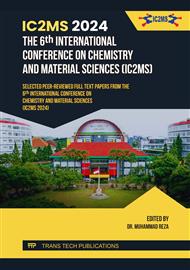[1]
L. E. P. Real, 'Plastic Materials and Additives', in Recycled Materials for Construction Applications, Cham: Springer International Publishing, 2023, p.19–33.
DOI: 10.1007/978-3-031-14872-9_2
Google Scholar
[2]
A. Razavykia, E. Brusa, C. Delprete, and R. Yavari, 'An Overview of Additive Manufacturing Technologies—A Review to Technical Synthesis in Numerical Study of Selective Laser Melting', Materials, vol. 13, no. 17, p.3895, Sep. 2020.
DOI: 10.3390/ma13173895
Google Scholar
[3]
N. Qaud, 'Additive manufacturing technologies at Sulzer'. Accessed: Oct. 16, 2024. [Online]. Available: https://www.researchgate.net/publication/326177846_Additive_manufacturing_technologies_at_Sulzer
Google Scholar
[4]
F. Madaraka Mwema and E. Titilayo Akinlabi, 'Basics of Fused Deposition Modelling (FDM)', in Fused Deposition Modeling, Manufacturing and Surface Engineering, vol. 1, 2020, p.1–15.
DOI: 10.1007/978-3-030-48259-6_1
Google Scholar
[5]
D. Srinivasan et al., '3D Printing Manufacturing Techniques, Materials, and Applications: An Overview', Advances in Materials Science and Engineering, vol. 2021, p.1–10, Dec. 2021.
DOI: 10.1155/2021/5756563
Google Scholar
[6]
H. Gunaydin, Kadir & S. Türkmen, 'Common FDM 3D Printing Defects', International Congress on 3D Printing (Additive Manufacturing) Technologies and Digital Industry, no. April, p.1–8, 2018.
Google Scholar
[7]
A. Of et al., 'Analysis Of The Effect Of Infill Pattern , Raster Angle , Print Speed And Bed Temperature On 3d Printing On Mechanical Properties With Steel-Pla Filament', vol. 0, no. 2021, p.1–4, 2022.
Google Scholar
[8]
W. Liu, J. Zhou, Y. Ma, J. Wang, and J. Xu, 'Fabrication of PLA Filaments and its Printable Performance', IOP Conf Ser Mater Sci Eng, vol. 275, no. 1, 2018.
DOI: 10.1088/1757-899X/275/1/012033
Google Scholar
[9]
ASTM International, 'ASTM D638-22 Standard Test Method for Tensile Properties of Plastics', https://www.astm.org/d0638-22.html.
Google Scholar
[10]
K. Krishnaiah and P. Shahabudeen, Applied Design of Experiments and Taguchi Method. New Delhi: PHI Learning Private Limited, 2012.
Google Scholar
[11]
M. Darsin, N. A. Mahardika, G. Jatisukamto, M. E. Ramadhan, B. A. Fachri, and M. S. Hussin, 'Effect of 3D Printing Parameters on Dimensional Accuracy Using eSteel Filaments', Journal Of 3D Printing And Additive Manufacturing, vol. 1, no. 1, Sep. 2022.
DOI: 10.53996/2833-5430.jpam.1000102
Google Scholar
[12]
V. D. Sagias, K. I. Giannakopoulos, and C. Stergiou, 'Mechanical properties of 3D printed polymer specimens', Procedia Structural Integrity, vol. 10, p.85–90, 2018.
DOI: 10.1016/j.prostr.2018.09.013
Google Scholar
[13]
N. Kumar Maurya, V. Rastogi, and P. Singh, 'Investigation of dimensional accuracy and international tolerance grades of 3D printed polycarbonate parts', Mater Today Proc, vol. 25, p.537–543, 2020.
DOI: 10.1016/j.matpr.2019.06.007
Google Scholar
[14]
M. Kafara, J. Kemnitzer, H.-H. Westermann, and R. Steinhilper, 'Influence of Binder Quantity on Dimensional Accuracy and Resilience in 3D-Printing', Procedia Manuf, vol. 21, p.638–646, 2018.
DOI: 10.1016/j.promfg.2018.02.166
Google Scholar
[15]
A. M. M. Nazmul Ahsan and B. Khoda, 'Characterizing Novel Honeycomb Infill Pattern for Additive Manufacturing', J Manuf Sci Eng, vol. 143, no. 2, Feb. 2021.
DOI: 10.1115/1.4048044
Google Scholar
[16]
G. Poojitha, P. Talari, S. Banoth, and A. Kumar, 'Effects of combined infill angle with honeycomb pattern on the mechanical properties of HIPS and polypropylene in FDM process', Mater Today Proc, Oct. 2023.
DOI: 10.1016/j.matpr.2023.09.219
Google Scholar
[17]
C. Hamzaçebi, 'Taguchi Method as a Robust Design Tool', in Quality Control - Intelligent Manufacturing, Robust Design and Charts, IntechOpen, 2021.
DOI: 10.5772/intechopen.94908
Google Scholar
[18]
R. H. Abdul Haq et al., 'Mechanical Properties of PCL/PLA Composite Sample Produced from 3D Printer and Injection Molding', International Journal of Integrated Engineering, vol. 11, no. 5, Aug. 2019.
DOI: 10.30880/ijie.2019.11.05.014
Google Scholar
[19]
S.-Y. Yoo, S.-K. Kim, S.-J. Heo, J.-Y. Koak, and J.-G. Kim, 'Dimensional Accuracy of Dental Models for Three-Unit Prostheses Fabricated by Various 3D Printing Technologies', Materials, vol. 14, no. 6, p.1550, Mar. 2021.
DOI: 10.3390/ma14061550
Google Scholar
[20]
J. F. C. Khaw, B. S. Lim, and L. E. N. Lim, 'Optimal design of neural networks using the Taguchi method', Neurocomputing, vol. 7, no. 3, p.225–245, Apr. 1995.
DOI: 10.1016/0925-2312(94)00013-I
Google Scholar
[21]
P. M. George, N. Pillai, and N. Shah, 'Optimization of shot peening parameters using Taguchi technique', J Mater Process Technol, vol. 153–154, p.925–930, Nov. 2004.
DOI: 10.1016/j.jmatprotec.2004.04.159
Google Scholar
[22]
B. Aloyaydi, S. Sivasankaran, and A. Mustafa, 'Investigation of infill-patterns on mechanical response of 3D printed poly-lactic-acid', Polym Test, vol. 87, no. April, p.106557, 2020.
DOI: 10.1016/j.polymertesting.2020.106557
Google Scholar
[23]
D. W. Adams and C. J. Turner, 'Effect of implicitly derived infill patterns on mechanical properties', Proceedings of the ASME Design Engineering Technical Conference, vol. 1, 2017.
DOI: 10.1115/DETC2017-67572
Google Scholar
[24]
M. Galeja, A. Hejna, P. Kosmela, and A. Kulawik, 'Static and Dynamic Mechanical Properties of 3D Printed ABS as a Function of Raster Angle', Materials, vol. 13, no. 2, p.297, Jan. 2020.
DOI: 10.3390/ma13020297
Google Scholar
[25]
M. Darsin, R. L. Amir, H. Sutjahjono, M. E. Ramadhan, and Y. Hermawan, 'The Effect of Nozzle Temperature , Layer Height , and Infill Pattern on Dimensional Accuracy and Flexural Strength of 3D Printed Cu-PLA Filaments', Gongcheng Kexue Yu Jishu/Advanced Engineering Science, vol. 54, no. 03, p.1437
Google Scholar
[26]
M. Spoerk, J. Gonzalez-Gutierrez, J. Sapkota, S. Schuschnigg, and C. Holzer, 'Effect of the printing bed temperature on the adhesion of parts produced by fused filament fabrication', Plastics, Rubber and Composites, vol. 47, no. 1, p.17–24, 2018.
DOI: 10.1080/14658011.2017.1399531
Google Scholar


